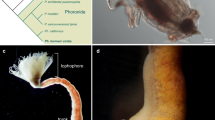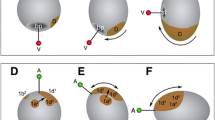Abstract
Hox and ParaHox genes are implicated in axial patterning of cnidarians and bilaterians, and are thought to have originated by tandem duplication of a single “ProtoHox” gene followed by duplication of the resultant gene cluster. It is unclear what the ancestral role of Hox/ParaHox genes was before the divergence of Cnidaria and Bilateria, or what roles the postulated ProtoHox gene(s) played. Here we describe the full coding region, spatial expression and function of Trox-2, the single Hox/ParaHox-type gene identified in Trichoplax adhaerens (phylum Placozoa) and either a candidate ProtoHox or a ParaHox gene. Trox-2 is expressed in a ring around the periphery of Trichoplax, in small cells located between the outer margins of the upper and lower epithelial cell layers. Inhibition of Trox-2 function, either by uptake of morpholino antisense oligonucleotides or by RNA interference, causes complete cessation of growth and binary fission. We speculate that Trox-2 functions within a hitherto unrecognized population of possibly multipotential peripheral stem cells that contribute to differentiated cells at the epithelial boundary of Trichoplax.





Similar content being viewed by others
References
Blackstone NW, Jasker BD (2003) Phylogenetic considerations of clonality, coloniality, and mode of germline development in animals. J Exp Zool Part B Mol Dev Evol 297:35–47
Bosch TC, David CN (1984) Growth regulation in Hydra: relationship between epithelial cell cycle length and growth rate. Dev Biol 104:161–171
Brooke NM, Garcia-Fernandez J, Holland PWH (1998) The ParaHox gene cluster is an evolutionary sister of the Hox gene cluster. Nature 392:920–922
Cartwright P, Bowsher J, Buss LW (1999) Expression of a Hox gene, Cnox-2, and the division of labor in a colonial hydroid. Proc Natl Acad Sci USA 96:2183–2186
Ender A, Schierwater B (2003) Placozoa are not derived cnidarians: evidence from molecular morphology. Mol Biol Evol 20:130–134
Ferrier DE, Holland PWH (2001) Sipunculan ParaHox genes. Evol Dev 3:263–270
Ferrier DE, Holland PWH (2002) Ciona intestinalis ParaHox genes: evolution of Hox/ParaHox cluster integrity, developmental mode, and temporal colinearity. Mol Phylogenet Evol 24:412–417
Finnerty JR, Martindale MQ (1999) Ancient origins of axial patterning genes: Hox genes and ParaHox genes in the Cnidaria. Evol Dev 1:16–23
Finnerty JR, Paulson D, Burton P, Pang K, Martindale MQ (2003) Early evolution of a homeobox gene: the parahox gene Gsx in the Cnidaria and the Bilateria. Evol Dev 5:331–345
Gauchat D, Mazet F, Berney C, Schummer M, Kreger S, Pawlowski J, Galliot B (2000) Evolution of Antp-class genes and differential expression of Hydra Hox/paraHox genes in anterior patterning. Proc Natl Acad Sci USA 97E:4493–4498
Grell KG (1972) Eibildung und Furchung von Trichoplax adhaerens F.E. Schulze (Placozoa). Z Morphol Tiere 73:297–314
Grell KG (1983) Ein neues Kulturverfahren für Trichoplax adhaerens F.E. Schulze. Z Naturforsch 38c:1072
Gröger H, Callaerts P, Gehring WJ, Schmid V (1999) Gene duplication and recruitment of a specific tropomyocin to striated muscle cells in the jellyfish, Podocoryne carnea. J Exp Zool 285:378–386
Kuhn K, Streit B, Schierwater B (1999) Isolation of Hox genes from the scyphozoan Cassiopeia xamachana: implications for the early evolution of Hox genes. J Exp Zool 285:63–75
Li YX, Farrell MJ, Liu R, Mohanty N, Kirby ML (2000) Double-stranded RNA injection produces null phenotypes in zebrafish. Dev Biol 217:394–405
Martinelli C, Spring J (2003) Distinct expression patterns of the two T-box homologues Brachyury and Tbx2/3 in the placozoan Trichoplax adhaerens. Dev Genes Evol 213:492–499
Morcos PA (2001) Achieving efficient delivery of Morpholino oligos in cultured cells. Genesis 30:94–102
Müller P, Yanze N, Schmid V, Spring J (1999) The homeobox gene Otx of the jellyfish Podocoryne carnea: role of a head gene in striated muscle and evolution. Dev Biol 216:582–593
Partridge M, Vincent A, Matthews P, Puma J, Stein D, Summerton J (1996) A simple method for delivering morpholino antisense oligos into the cytoplasm of cells. Antisense Nucleic Acid Drug Dev 169
Pearse VB, Uehara T, Miller RL (1994) Birefringent granules in placozoans (Trichoplax adhaerens). Trans Am Microsc Soc 113:385–389
Plaza S, Prince F, Jaeger J, Kloter U, Flister S, Benassayag C, Cribbs D, Gehring WJ (2001) Molecular basis for the inhibition of Drosophila eye development by Antennapedia. Embo J 20:802–811
Rassat J, Ruthmann A (1979) Trichoplax adhaerens F.E. Schulze (Placozoa) in the scanning electron microscope. Zoomorphology 93:59–72
Rokas A, King N, Finnerty J, Carroll SB (2003) Conflicting phylogenetic signals at the base of the metazoan tree. Evol Dev 5:346–359
Ronshaugen M, McGinnis N, McGinnis W (2002) Hox protein mutation and macroevolution of the insect body plan. Nature 415:914–917
Sarkar IN, Thornton JW, Planet PJ, Figurski DH, Schierwater B, DeSalle R (2002) An automated phylogenetic key for classifying homeoboxes. Mol Phylogenet Evol 24:388–399
Schierwater B, Desalle R (2001) Current problems with the zootype and the early evolution of Hox genes. J Exp Zool 291:169–174
Schierwater B, Kuhn K (1998) Homology of Hox genes and the zootype concept in early metazoan evolution. Mol Phylogenet Evol 9:375–381
Schierwater B, Dellaporta S, DeSalle R (2002) Is the evolution of Cnox-2 Hox/ParaHox genes “multicolored” and “polygenealogical?” Mol Phylogenet Evol 24:374–378
Schuchert P (1993) Trichoplax adhaerens (phylum Placozoa) has cells that react with antibodies against the neuropeptide RFamide. Acta Zool (Stockholm) 74:115–117
Schwartz V (1984) Das radiopolare Differenzierungsmuster bei Trichoplax adhaerens F.E. Schulze (Placozoa). Z Naturforsch 39c:818–832
Shenk MA, Bode HR, Steele RE (1993) Expression of Cnox-2, a HOM/HOX homeobox gene in hydra, is correlated with axial pattern formation. Development 117:657–667
Summerton J, Weller D (1997) Morpholino antisense oligomers: design, preparation and properties. Antisense Nucleic Acid Drug Dev 187
Summerton J, Stein D, Huang SB, Matthews P, Weller D, Partridge M (1997) Morpholino and phosphorothioate antisense oligomers compared in cell-free and cell-system. Antisense Nucleic Acid Drug Dev 63
Syed T, Schierwater B (2002) Trichoplax adhaerens: discovered as a missing link, forgotten as a hydrozoan, re-discovered as a key to metazoan evolution. Vie Milieu 52:177–187
Yanze N, Spring J, Schmidli C, Schmid V (2001) Conservation of Hox/ParaHox-related genes in the early development of a cnidarian. Dev Biol 236:89–98
Acknowledgements
This work was supported by the German Science Foundation, (DFG Schi 277/10-2), the Human Frontier Science Program (HFSP RGP0221/2001-M), and the Graduiertenförderung Niedersachsen (fellowship to W.J.). We are grateful to Jutta Bunnenberg for technical assistance, and two anonymous reviewers for valuable and constructive comments.
Author information
Authors and Affiliations
Corresponding author
Additional information
Edited by D. Tautz
Rights and permissions
About this article
Cite this article
Jakob, W., Sagasser, S., Dellaporta, S. et al. The Trox-2 Hox/ParaHox gene of Trichoplax (Placozoa) marks an epithelial boundary. Dev Genes Evol 214, 170–175 (2004). https://doi.org/10.1007/s00427-004-0390-8
Received:
Accepted:
Published:
Issue Date:
DOI: https://doi.org/10.1007/s00427-004-0390-8





